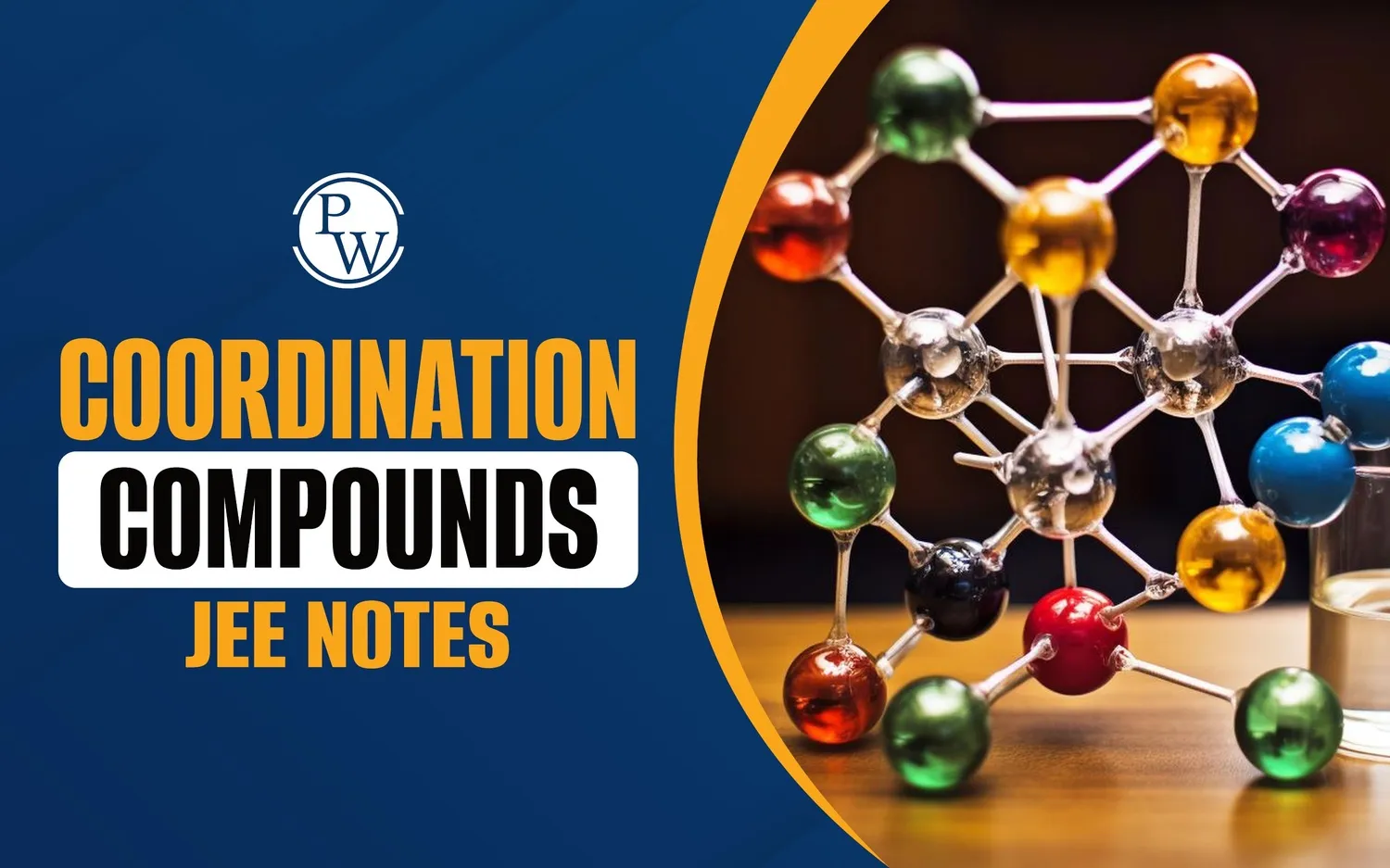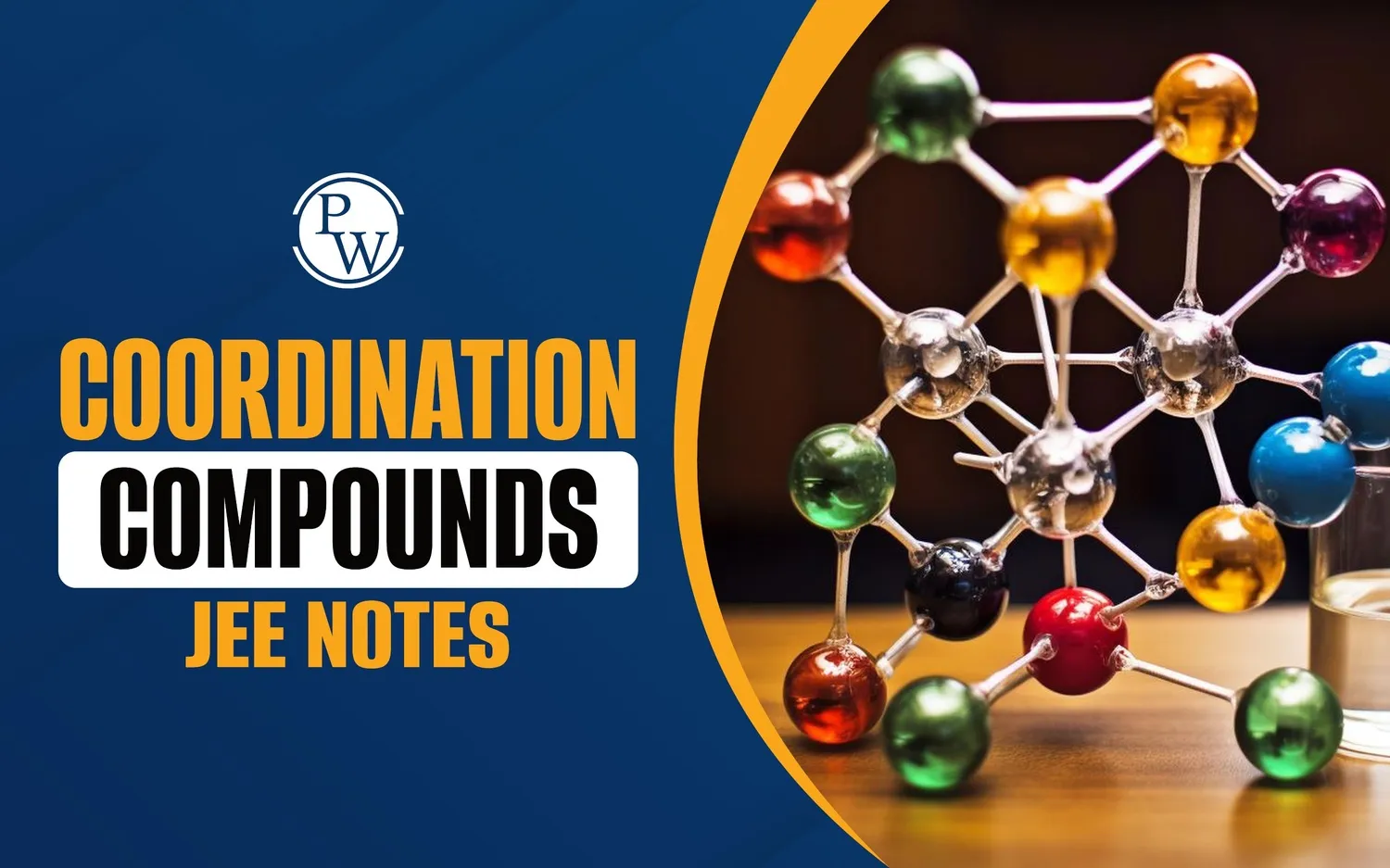

Coordination Compounds are an important chapter in Chemistry for JEE aspirants, as questions from this topic appear every year in JEE Main exams. These compounds consist of a central metal atom bonded with ligands, giving them unique chemical properties and wide applications in medicine, industries, and daily life.
Below provides complete Coordination Compounds JEE Notes, including definitions, key formulas, solved examples, and important questions. Students can also find the Coordination Compounds JEE Notes PDF for quick revision before exams.
By understanding oxidation numbers, hybridization, ligand types, and coordination numbers, students can solve questions faster and improve accuracy. Regular practice with these notes ensures better performance and higher JEE Main scores.
What are Coordination Compounds?
Coordination compounds are special types of chemical compounds. They have a central metal atom bonded to molecules or ions called ligands. Ligands act like helpers to the metal, making new properties for the compound. These compounds are used in medicine, industry, and daily life.
Also Check:
Features of Coordination Compounds
These compounds have a central metal ion surrounded by ligands, with the number of ligands defining the coordination number, and are widely used in industries for coloring and medicine preparation. The key features include:
-
Central metal ion in the middle
-
Ligands surround the metal ion
-
The number of ligands is the coordination number
-
Used in industries for coloring and making medicines
Coordination Compounds JEE Formulas
Formulas help students solve questions fast during exams. Coordination Compounds formulas JEE are easy to remember when you group them topic-wise. Below is an introduction to common formulas:
|
Coordination Compounds JEE Formulas |
||
|
Formula Name |
Formula |
Usage Example |
|
Coordination number |
Number of attached ligands |
[Ni(NH₃)₄]²⁺ → 4 |
|
Oxidation number |
Sum of charges on ligands/metals |
[Cr(NH₃)₆]Cl₃ → +3 |
|
Hybridization of central atom |
Depends on ligand/geometry |
sp³, d²sp³, dsp² |
|
Magnetic property |
Unpaired electrons count |
Diamagnetic/Paramagnetic |
|
Types of ligands |
Monodentate, bidentate, polydentate |
NH₃, EDTA, etc. |
These formulas make it easy for JEE students to answer questions fast.
Coordination Compounds JEE Main Notes
Coordination Compounds JEE Main notes give a clear overview for fast revision before exams. Students prefer these notes as they save time and keep information handy. Notes usually include formulas, chemical properties, and exam tips.
|
Topic Covered |
Short Description |
|
Definition and Types |
Simple explanation |
|
Formulas and Properties |
For quick calculation |
|
Solved Examples |
Practice problems |
|
Exam Tips |
How to answer quickly |
Good notes help students revise regularly and improve their score in JEE Main.
Coordination Compounds JEE Notes PDF
Students often need detailed notes for fast revision. Coordination Compounds JEE Notes PDF can be downloaded from coaching websites, which help organize learning. The PDF covers all topics, including definitions, formulas, solved examples, and important questions.
Download Coordination Compounds JEE Notes PDF
Revision becomes easy and less stressful for students during exam times with these notes.
Coordination Compounds JEE Important Questions
Questions from coordination compounds appear every year in JEE Main exams. Solving these helps students practice different types of questions. Practice makes you better and gives you confidence. Here is some information before practicing questions. Attempting past year questions strengthens concepts and improves exam speed.
JEE Main usually gives 2–3 questions every year from this chapter. Here are some of the key questions:
-
What is a coordination compound?
-
How do you write the formula of a coordination compound?
-
What is the coordination number in a complex?
-
Name some common ligands used in coordination compounds.
-
How is the hybridization of the central metal atom determined in coordination complexes?
-
What are the different types of isomerism seen in coordination compounds?
-
How does ligand size affect the stability of a complex?
-
Explain the concept of chelation in coordination chemistry.
-
What are the steps to balance the oxidation number in a coordination complex?
-
How do you classify ligands based on their bonding properties?
Coordination Compounds JEE Solved Examples
Studying Coordination Compounds solved examples JEE makes learning easy for everyone. These examples help students understand how formulas work in real questions. Practice with solved examples increases accuracy.
Before the solved examples, remember that using Coordination Compounds JEE Notes for practice improves understanding:
|
Example Question |
Solution Steps |
Answer |
|
Find oxidation number of Fe in [Fe(CN)₆]⁴⁻ |
Assign charges to CN⁻, Fe |
Fe: +2 |
|
What is coordination number in [Co(NH₃)₆]Cl₃ |
Count ligands around Co |
6 |
|
Identify hybridization in [Ni(CO)₄] |
Check geometry and ligands |
sp³ |
|
Is [Cu(NH₃)₄]²⁺ paramagnetic or diamagnetic? |
Count unpaired electrons |
Paramagnetic |
Solving examples daily helps students answer exam questions confidently.
Chemical Formulas and Uses
Coordination compounds JEE notes include chemical formulas and uses for different compounds, which help students remember them better. These compounds are present in medicine, coloring agents, and agriculture.
-
[Fe(CN)₆]³⁻ is used in making dyes.
-
[Ni(CO)₄] is used in industry for nickel purification.
-
[Pt(NH₃)₂Cl₂] is used in cancer treatment in hospitals.
-
[Cu(NH₃)₄]²⁺ is used as a chemical test for copper presence.
Remembering both formulas and uses is important for exams and real life.
